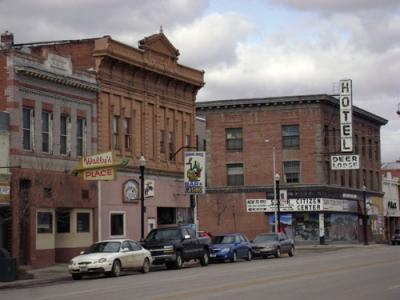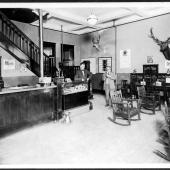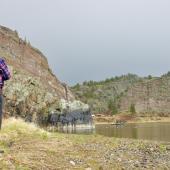Doin' Time at Deer Lodge
Historic town and state prison...
Majestic, snowcapped peaks encircle the sprawling Deer Lodge valley where one of Montana’s first permanent settlements took root. Today, this friendly community remains loyal to its pioneer roots and welcomes curious visitors who come from every corner of the world to explore its surprising faces. Home of the Grant-Kohrs Ranch National Historic Site and the Old Montana Prison Museum, Deer Lodge boasts significant cultural attractions, small-town hospitality, and an impressive array of nearby recreational opportunities. Whether you spend an hour, a day, or more, Deer Lodge and the surrounding area offer uniquely western experiences, family adventures, and a whole lot of history. It’s a singular place to “do some time.”

The gentle Deer Lodge valley follows a well-worn ancient travel corridor. It was a trade route and place of encampment for generations of Montana’s native people and a place of rendezvous for French trappers and traders. Today, cattle graze against the landscape on the ranches that dot the countryside.
The valley takes its name from a curious sedimentary mound where a thermal spring bubbled up from within. The steam rising into blue skies on chilly days resembled a huge Indian lodge with smoke curling from its smoke hole. Herds of deer grazed on the lush grass growing at the mound’s base, prompting its Indian name, It Soo Kee En Carne. The French translated it as La Loge Du Chevreuil or Lodge of the White-Tailed Deer. White settlers later shortened it to Deer Lodge.
Johnny Grant and his Bannock wife, Quarra, were the first to realize its ranching potential. They brought 250 head of horses and 800 cattle into the Deer Lodge valley in 1859. Indians, Mexicans, whites, and Canadian Metis like Johnny himself soon joined the Grants in the Deer Lodge Valley. It was a lively, ethnically diverse settlement called Grantsville. But spring flooding in 1861 forced the Grants to relocate on the present ranch site. Grant built two cabins, joining them together for his several Indian wives and numerous children. The Grants’ far-famed hospitality drew diverse travelers and visitors.
In the fall of 1862, Grant built one of the first clapboard homes in the territory. [#2] Its twenty-eight glass window panes, packed in sawdust and shipped at great expense by steamboat to Fort Benton, then freighted overland to the valley, expressed the Grants’ wealth and importance. Then gold discoveries in western Montana clashed with the Grants’ pastoral lifestyle. Newcomers were intolerant of other cultures and inter-racial marriages. Indians ran off Grant’s cattle, an arsonist destroyed his best barn, and the United States revenue officer seized hundreds of gallons of liquor that stocked his saloon. Grant told the Montana Post that he would find a safer place and take his children away from “such a rough country as Montana.”
Conrad Kohrs, a friend of Grant’s whom he had assisted financially, solved Grant’s problem by purchasing the ranch and the house for $19,200 in 1866. Soon after, Quarra died of tuberculosis, leaving six children. Grant and his large extended family left the Deer Lodge valley for Manitoba, Canada in 1867. [#3]
Conrad Kohrs and his wife, Augusta, raised their three children on the ranch and built their own empire. Kohrs and his half-brother and partner, John Bielenberg, raised some of Montana’s best stock in the Deer Lodge valley. Bielenberg introduced thoroughbred stallions into the valley in the early 1870s while Kohrs pioneered the management, feed production, and breeding of cattle as Montana’s livestock industry burgeoned. The ranch shipped eight to ten thousand head to market every year.
Ownership of the working ranch remained in the Kohrs family through grandson Conrad Warren. In 1970, the National Park Foundation purchased a portion of the ranch property including the house and buildings. Warren generously donated the building’s contents, and the Park Service began intensive restoration, opening the ranch to the public in 1977. [#4 and #5]
Visitors can tour the beautifully furnished Victorian era home, the barns, the bunkhouse—originally the two adjoined log cabins that were the Grants’ first home on the ranch—and other buildings. It remains a working ranch with imported draft horses and purebred cattle. To wander among the home and the outbuildings and explore their many treasures is to step back to the time the ranch founders knew. [#6]
As the Grant-Kohrs Ranch established itself in the valley north of the settlement of Deer Lodge, another industry began to take shape in the town itself. The territorial legislature chose to locate the federal penitentiary there. The facility received its first prisoners in 1871 and law enforcement became an integral part of the local economy. Federal authority passed to Montana upon statehood in 1889 and thereafter the state penitentiary expanded, uniquely coloring the evolution of this agricultural community.
Deer Lodge grew like other small Montana towns with enthusiastic residents. A public school opened in 1865 and Montana’s first college, Montana Collegiate Institute, opened in Deer Lodge in 1878. Built atop a rise called College Hill, Trask Hall—the state’s oldest college building—still serves the local school district. Early churches and beautiful historic homes of ranchers, bankers, and businessmen grace the streetscapes. [#7 and #8] Its homey and appealing Main Street, however, has one feature no other Montana main street claims: the massive east wall of the historic prison runs along several blocks at its southern end.
Under the patient tutelage of contractor, James McCalman, convicts cut and shaped the stone and built the wall enclosing the prison. Completed in 1894, the wall was a model nationally touted. Critics pronounced it an architectural marvel and a monument to convict labor and skill. Its grand round corner towers, crenellated and imposing, recall Cinderella’s castle. [#9] Inside these walls, however, were no dancing lords and ladies.
During the next century, the prison kept many Deer Lodge residents employed and the community maintained a symbiotic relationship with its formidable neighbor. Copper king, W. A. Clark, who first settled in Deer Lodge and later made his fortune mining copper in Butte, left his vast wealth to other states. Deer Lodge has the only physical evidence of his generosity to Montana: a theatre built inside the prison walls in 1919. Clark gave $10,000 to build the theatre out of gratitude to the prison’s longtime controversial warden, Frank Conley, for the use of prison labor in his mines and on his ranch. It was the first theatre built inside a prison in the nation, and served not only inmates, but the community as well. Traveling musical troupes and featured motion pictures had separate showings for the inmates and for the public. [#10]
In 1959, a prison riot left the community terrified. Inmates brandishing mops soaked in flammable liquid took 18 employees and five fellow prisoners hostage. Deputy Warden Ted Rothe was killed at the start of the three-day incident that brought Deer Lodge national press. The community held its breath as the National Guard, armed with machine guns, a WWII vintage bazooka, and tear gas, finally stormed the tower where the inmates holed up. In the assault, the soldiers launched three rockets aimed from inside the walls. Had any of these rockets missed, they would have shot across Main Street and exploded into residential streets.
A new state prison, built outside of town, left the century-old institution empty in 1979. The Powell County Arts Museum and Foundation opened it as a museum in 1980. Experience this dark chapter of Montana’s past with a guide or on your own. [#11] The complex, listed in the National Register of Historic Places, includes multiple museums inside and outside the prison walls. A law enforcement museum; one of the nation’s best vintage automobile collections; Yesterday’s Playthings, a renowned toy and doll museum; and Desert John’s Saloon featuring the most complete whiskey memorabilia display in the United States are among the attractions.
While you are doin’ time in the Deer Lodge valley, you may take advantage of the multiple recreational spots. To the northeast, anglers can cast their lines in the Little Blackfoot River, one of Southwestern Montana’s best-kept secrets. This lovely little stream tumbles 40 miles through the woods along a Forest Service road. Downstream access is excellent along Highway 12 from south of Elliston to the river’s confluence with the Clark Fork at the town of Garrison, a dozen miles north of Deer Lodge. The Little Blackfoot yields large brown trout below Elliston, brook and cutthroats above, and whitefish along its entire length. Natural springs keep the water warm enough for catch-and-release trout fishing even during the coldest winter months. [#12]
Twenty-five miles south of Deer Lodge at Opportunity is the gateway to the picturesque Pintler Scenic Route. This must-see drive offers 60 miles of sweeping vistas over mountain passes and gentle sage covered hills, past the historic copper smelter town of Anaconda, along the shores of Georgetown Lake, to the quaint mining town of Philipsburg and the nearby ruins of the ghost town of Granite.
Fantastic winter sports are close by at Discovery Ski Area, above Georgetown Lake. This regional secret promises something for everyone and everything for an unforgettable adventure: lessons, rentals, great food, and shopping. Lift-served opportunities include tree skiing, powder bowls, moguls, groomed trails, and great boarding for the beginner, intermediate, advanced, and expert enthusiast. Discovery prides itself on breathtaking views and 614 acres of runs over 2100 acres of National Forest.
If it is off-season for skiing, a family outing to Crystal Park is a worthwhile day trip. To find this rockhound’s haven, take the interstate about 65 miles south of Deer Lodge to Wise River, then another 25 miles on the Pioneer Mountains Scenic Byway Road. This unusual park yields crystals both above and below the ground, free for the taking or digging. The Forest Service reserves Crystal Park exclusively for rockhounding May 15 to September 30, road conditions permitting.
Fairmont Hot Springs Resort, a quick 20 minutes down the interstate from Deer Lodge, is the perfect place to rest and revive regardless of the season. It’s also a great home base for exploring this special slice of Southwestern Montana. Generations of Native Americans traveling through the area enjoyed its 12 soothing hot water pools. In 1869, the Gregson brothers built the first hotel and plunge there. Visitors from around the world have since enjoyed Montana’s largest hot springs. Farimont offers tennis courts, a wildlife zoo, playground and waterslide, and fine dining. It is also famous for its outstanding golf course featuring Montana’s largest, 10,000 square foot putting green and the challenging “mile high, mile long” 5th hole. [#13]
Explore Montana’s earliest settlement history, agricultural roots, and its darker side in the Deer Lodge valley. Then enjoy Montana’s unsurpassed beauty and nearby recreational opportunities. You’ll surely find that doin’ time here won’t be hard.
~ Ellen Baumler is the author of several award-winning books and the interpretive historian at the Montana Historical Society. Her most recent project, forthcoming in 2008, is a collaboration with photographer, J. M. Cooper, documenting the untold history of the Montana State Prison.












Leave a Comment Here